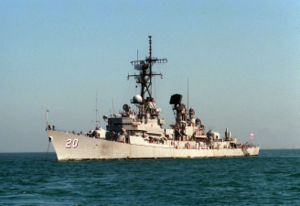- USS Goldsborough (DDG-20)
-

USS Goldsborough (DDG-20)Career (US) 
Name: Goldsborough (DDG-20) Namesake: Rear Admiral Louis M. Goldsborough Ordered: 25 March 1960 Builder: Puget Sound Bridge and Drydock Company, Seattle, Washington Laid down: 3 January 1961 Launched: 15 December 1961 Commissioned: 9 November 1963 Decommissioned: 29 April 1993 Struck: 29 April 1993 Motto: Non Sibi - "Not for self" Fate: sold to Australia for parts and scrapped General characteristics Class and type: Charles F. Adams-class destroyer Displacement: 3,277 tons standard, 4,526 full load Length: 437 ft (133 m) Beam: 47 ft (14 m) Draft: 15 ft (4.6 m) Propulsion: 2 × General Electric steam turbines providing 70,000 shp (52 MW); 2 shafts
4 x Babcock and Wilcox 1,275 psi (8,790 kPa) boilersSpeed: 33 knots (61 km/h) Range: 4,500 nautical miles (8,300 km) at 20 knots (37 km/h) Complement: 354 (24 officers, 330 enlisted) Sensors and
processing systems:AN/SPS-39 3D air search radar
AN/SPS-10 surface search radar
AN/SPG-51 missile fire control radar
AN/SPG-53 gunfire control radar
AN/SQS-23 Sonar and the hull mounted SQQ-23 Pair Sonar for DDG-2 through 19
AN/SPS-40 Air Search RadarArmament: 1 Mark 11 launcher (DDG2-14) or Mark 13 single arm launcher (DDG-15-24) for Tartar SAM system or later the Standard SM-1 and Harpoon antiship missile
2x Mark 42 5in(127mm)/54
1x ASROC Launcher
6x 12.8in(324mm) ASW Torpedo Tubes (2xMark 32 Surface Vessel Torpedo Tubes)Aircraft carried: None USS Goldsborough (DDG-20), named for Rear Admiral Louis M. Goldsborough USN (1805–1877), was a Charles F. Adams-class guided missile armed destroyer.
Goldsborough was laid down by the Puget Sound Bridge and Drydock Company at Seattle in Washington on 3 January 1961, launched on 15 December 1961 by Mrs. Alan Bible, wife of U.S. Senator Alan Bible of Nevada and commissioned on 9 November 1963, Captain Charles D. Allen, Jr., in command.
Contents
1960s
Goldsborough joined the U.S. Pacific Fleet 25 December 1963, as a unit of Cruiser-Destroyer Force with home-port at Pearl Harbor.
After shakedown out of Puget Sound, the new guided missile destroyer arrived Pearl Harbor 14 February 1964. Following qualification and acceptance tests, she sailed 18 April for Sydney, Australia, for the Coral Sea celebration and returned Pearl Harbor 1 June. She operated in Hawaiian waters in the summer and early fall, then got underway 23 November for Yokosuka and her first West-Pac deployment. After operations strengthening the 7th Fleet during the escalating war in Vietnam, Goldsborough returned to Pearl for ASW training.
The guided missile destroyer headed for the Orient once more 9 February 1966 to bolster the 7th Fleet. In April she provided gunfire support for Operation "Binh Phu I" firing 594 rounds of 5" ammunition at Viet Cong troop concentration and buildings. During the last half of the month she screened attack carriers at Yankee Station. Next came SEATO exercises in May and duty as station ship at Hong Kong in June. On 26 June Goldsborough was again off Vietnam on picket station. She sailed for Hawaii 16 July and reach Pearl Harbor on the 23d.
While in berth at Pearl Harbor, Hawaii an anti-submarine torpedo was discharged from the ship and landed on the pier on the 24th of November, 1965.
A month later she entered the Pearl Harbor Naval Shipyard for overhaul and extensive modification to prepare for resumed action in 1967.
1980s
Seaman Jose Cantu was the only fatality from Hurricane Iwa in November 1982. Lieutenant Ray Beard survived the incident after being washed overboard with a broken arm.[citation needed]
Admiral James D. Watkins, Chief of Naval Operations visited the ship in January 1986. The Admiral remarked how he had previously sighted the ship in 1964 from his submarine's periscope, Snook, "Goldsborough looked formidable then, and still is a formidable warship now."[citation needed]
Goldsborough was decommissioned and stricken from the Naval Vessel Register on 29 April 1993[citation needed] and sold to Australia on 17 September[citation needed] 1993 as a parts hulk.[1] The ship arrived in Sydney in early 1994, and a four-man team set about removing equipment for installation in the Royal Australian Navy's Perth class destroyers (a derivative of the Charles F. Adams class).[1] While in Australian hands, the team painted the number 40 on the bow, filling a gap in the number sequence for their three destroyers.[1] After all usable equipment had been stripped, Goldsborough was sold to an Indian company in August 1994, and towed away for ship breaking.[1]
References
- This article includes text from the public domain Dictionary of American Naval Fighting Ships. The entry can be found here.
- This article includes information collected from the Naval Vessel Register, which, as a U.S. government publication, is in the public domain. The entry can be found here.
- ^ a b c d "Final Disposition". USS Goldsborough (DDG 20) Association. 2008. http://www.ussgoldsborough.com/dnn/History/FinalDisposition/tabid/192/Default.aspx. Retrieved 26 August 2011.
External links
 United States Navy
United States NavyCharles F. Adams · John King · Lawrence · Biddle ⁄ Claude V. Rickets · Barney · Henry B. Wilson · Lynde McCormick · Towers · Sampson · Sellers · Robison · Hoel · Buchanan · Berkeley · Joseph Strauss · Conyngham · Semmes · Tattnall · Goldsborough · Cochrane · Benjamin Stoddert · Richard E. Byrd · Waddell
 German Navy
German Navy
Lütjens class Royal Australian Navy
Royal Australian Navy
Perth class Hellenic Navy
Hellenic Navy
List of destroyers of the United States Navy · List of destroyer classes of the United States NavyCategories:- Cold War destroyers of the United States
- Vietnam War destroyers of the United States
- 1961 ships
- Charles F. Adams class destroyers of the United States Navy
Wikimedia Foundation. 2010.
